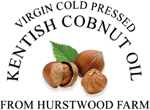In Mid November a group of us met at Hurstwood Farm for a visit to see how Kentish Cobnut Oil is made.
 |
| Cobnut trees make the backdrop as the group assembles |
Our host, nut farmer (and piano-maker), Richard Dain received us warmly with tea and biscuits and he and his assistant, Catherine, gave a talk explaining how it all came about.
 |
| Cathrine, right, explains |
When his extensive apple orchards suffered irreparable damage during the Great Storm of October 1987 Mr Dain decided a wiser move would be to replant with cobnuts rather than with apples. The idea for an oil press came later and, being an engineer by profession, he assembled the various parts, sourcing from Italy, Germany and using his own invention.
 |
| The barn where we sat doubles as a concert hall in summer |
The resulting cobnut oil was entered for the Great Taste Awards of the Guild of Fine Food and at its first appearance won not just best in its category but overall winner. It was a great start and Kentish Cobnut Oil has gone from strength to strength since then.
Making oil from cobnuts is not simply a question of feeding the nuts into a machine and bottling the oil that comes out. The process has many stages and we visited each in turn. First we saw the machine which makes boxes into which the bottles are packed for dispatch: different sizes for different numbers of bottles.
 |
| The machine will print boxes to suit your specifications |
But before any of that what about the actual process of making the oil? First the nuts must be dried and the moisture reduced to a particular degree. Then the nuts are cracked and the shells separated from the kernels. The kernels are fed into a hopper and thence into the pressing mechanism.
 |
| Nut kernals are drawn up the conveyor (right) into the hopper |
 |
| Richard Dain controls the pressing mechanism |
The resulting oil goes into containers and thence to the bottling plant.
 |
| Three bottles are filled before you can say 'nuts'! |
There is another element of this machine which secures the bottles with sealed caps.
 |
| Securing the familiar and distinctive labels |
Finally the bottles are labelled and are ready to be packed into their boxes.
Hurstwood farm has thirty acres of cobnuts and another seven acres of walnut trees which will be made into walnut oil once the necessary machinery has been installed. I think we would be willing guinea-pigs when it comes to trialling it!
You can buy Kentish cobnut Oil from Hurstwood Farm at the Shipbourne Farmers Market
(Thursdays from 9 to 11 am).

I too have supplies and will be happy to take your orders:
just phone 01732 761466
















